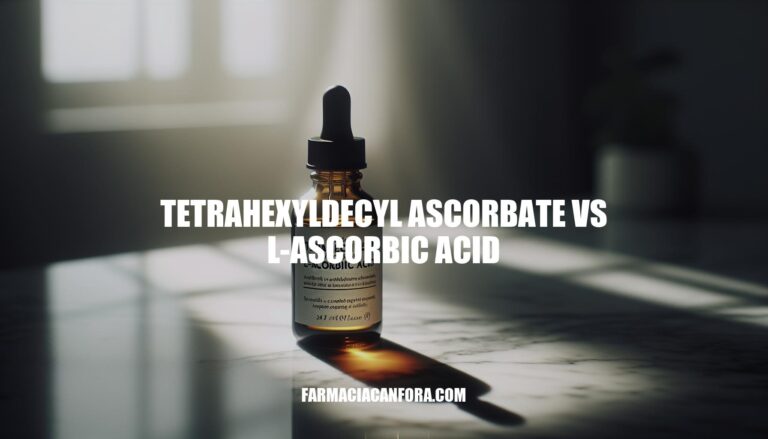Understanding the differences between tetrahexyldecyl ascorbate and L-ascorbic acid is crucial for anyone invested in skincare. Both are forms of vitamin C, but they differ significantly in stability, skin penetration, and potential benefits. Knowing these differences can help you choose the right product for your skin’s needs, ensuring you get the most out of your skincare routine.
Chemical Structure and Stability
Tetrahexyldecyl Ascorbate (THD Ascorbate) and L-Ascorbic Acid (LAA) are both forms of Vitamin C, but they differ significantly in their chemical structures and properties.
Chemical Structure:
- L-Ascorbic Acid (LAA): This is the pure form of Vitamin C, with a simple structure consisting of six carbon atoms, eight hydrogen atoms, and six oxygen atoms. It is water-soluble and highly acidic, with a pH range of 2.0 to 3.5.
- Tetrahexyldecyl Ascorbate (THD Ascorbate): This is a lipid-soluble derivative of Vitamin C. It has a more complex structure, incorporating a fatty acid chain, which makes it oil-soluble and less acidic, with a neutral pH around 3.
Stability and Oxidation:
- L-Ascorbic Acid: While highly effective, LAA is notoriously unstable. It is prone to oxidation when exposed to air, light, and heat, which can significantly reduce its efficacy.
- Tetrahexyldecyl Ascorbate: THD Ascorbate is much more stable due to its lipid-soluble nature. This stability allows it to resist oxidation and degradation, making it a more reliable ingredient in skincare formulations.
In summary, the lipid-soluble nature of Tetrahexyldecyl Ascorbate not only enhances its stability but also allows for better skin penetration and reduced irritation compared to the water-soluble L-Ascorbic Acid.
Skin Penetration and Absorption
Tetrahexyldecyl ascorbate (THD ascorbate) and L-ascorbic acid are both forms of vitamin C, but they differ significantly in terms of skin penetration and absorption:
- Solubility: THD ascorbate is lipid-soluble, meaning it dissolves in oils, while L-ascorbic acid is water-soluble.
- Skin Penetration: Due to its lipid solubility, THD ascorbate penetrates the skin more effectively, reaching both the epidermis and dermis. It surpasses the penetration of L-ascorbic acid by threefold at the same concentration.
- Stability: THD ascorbate is more stable and less irritating compared to L-ascorbic acid.
These differences make THD ascorbate a more efficient option for deeper skin absorption and longer-lasting effects.
Efficacy in Skincare
Here’s a direct comparison:
Collagen Production
- L-Ascorbic Acid: Known for its potent ability to stimulate collagen synthesis, making it highly effective in reducing wrinkles and improving skin texture.
- Tetrahexyldecyl Ascorbate: Also stimulates collagen production but is more stable and less irritating, making it suitable for sensitive skin.
Hyperpigmentation Reduction
- L-Ascorbic Acid: Effective in reducing hyperpigmentation and brightening the skin, but can be unstable and degrade quickly when exposed to light and air.
- Tetrahexyldecyl Ascorbate: Equally effective in reducing hyperpigmentation and is more stable, allowing for longer-lasting results.
Antioxidant Protection
- L-Ascorbic Acid: Provides strong antioxidant protection by neutralizing free radicals, but its efficacy can be compromised due to its instability.
- Tetrahexyldecyl Ascorbate: Offers robust antioxidant protection with better skin penetration and stability, ensuring more consistent results.
In summary, while both forms are effective, tetrahexyldecyl ascorbate offers enhanced stability and skin penetration, making it a versatile and less irritating option for skincare.
Potential Side Effects
Tetrahexyldecyl Ascorbate:
- Less Irritating: Generally less likely to cause irritation or skin sensitization due to its neutral pH.
- Mild Side Effects: Some individuals may experience mild irritation, redness, or dryness initially.
- Stability: More stable and less prone to oxidation.
L-Ascorbic Acid:
- Higher Irritation: Can cause irritation and dryness due to its highly acidic nature (pH 2.0 to 3.5).
- Potential for Sensitization: More likely to disrupt the skin’s natural pH balance, leading to potential sensitization.
Tetrahexyldecyl ascorbate is generally more suitable for sensitive skin due to its milder nature and stability.
Formulation and Product Compatibility
Tetrahexyldecyl ascorbate is a lipid-soluble form of vitamin C, making it more versatile for skincare formulations. It can be easily incorporated into oil-based products, providing better skin penetration and stability compared to L-ascorbic acid, which is water-soluble and can only be formulated in water-based products. This versatility allows tetrahexyldecyl ascorbate to be used in a wider range of skincare products, including serums and moisturizers.
Tetrahexyldecyl Ascorbate (THD) vs L-Ascorbic Acid (LAA): Understanding the Differences
Tetrahexyldecyl Ascorbate (THD) and L-Ascorbic Acid (LAA) are both forms of Vitamin C, but they differ in stability, skin penetration, and potential benefits.
THD is more stable, less irritating, and has better skin penetration than LAA. It is suitable for sensitive skin and can be used in a wider range of skincare products.
LAA is highly effective but unstable, making it prone to oxidation and degradation. For those with sensitive skin or looking for a more versatile option, THD may be the better choice. However, for those who prioritize potency and are willing to tolerate potential irritation, LAA could still be an effective option.


